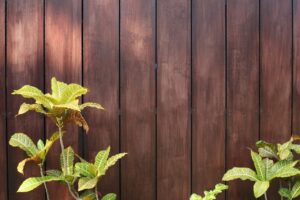Summer Fence Maintenance for Wooden Fencing
Wooden fencing comes in a variety of forms, not only in terms of design, but also in terms of the type of wood used to construct them. There are also various different construction methods, as well as a selection of finishes that are suitable for wooden fencing.
All these factors will affect your summer fence maintenance plan. So if you’re building a new fence, or getting an Atlanta fence company to erect one for you, bear all these factors in mind.
Wooden Fencing: Type and Style

The distinction between hardwoods and softwoods has nothing to do with the strength of the lumber, or its ability to withstand decay and rot. So summer fence maintenance will not necessarily be affected by which sort is used. Softwood lumber is cut from coniferous trees, while hardwoods come from various broad-leafed species.
- Perhaps ironically, some of the best naturally rot-resistant woods are softwoods, including redwood and cedar – particularly their heartwood. However as supply decreases, prices continue to increase. Pine and Douglas fir are also softwoods, but they do need to be pressure treated against insects and potential decay.
- Many of the suitable hardwoods grow in the tropics, including meranti, cambara, and ipé. The type of lumber you choose will depend on what your Atlanta fence company has available, as well as cost.
Irrespective of the lumber used, most wooden fences have the same basic components: vertical posts or poles that are set in the ground, and either a series of horizontal rails, or a skeletal structure of rails onto which vertical lattice panels or facing boards are attached.
Many contractors anchor posts into the ground using concrete, while others prefer to set posts on gravel and then pack earth around the post/poles. When it comes to summer fence maintenance, concrete can trap moisture, but earth that builds up against the fence can too. Your Atlanta fence company will be able to advise which method is best for you.
A Good Summer Fence Maintenance Plan
Summer fence maintenance should include removal of anything that might compromise the structural integrity of fencing, as well as cleaning, staining, resealing or repainting fences, depending on what is required.
If you maintain your yard regularly, you will probably already have removed weeds, overgrown plants and bushes, as well as any branches that threaten to crash down on fences during summer storms. If not, don’t put these tasks off any longer. Fixing damage is much more time consuming and expensive than a summer fence maintenance plan.
The next step is to clean the fence itself. If there is any sign of mold or mildew, it might be a good idea to hire a pressure washer. Otherwise you can wash very dirty areas by hand, using a little soapy water, and then hose it off. Once your wooden fence is clean and dry, you can decide whether you need to stain or seal the wood. If you did this in spring, a good clean will probably be enough for now.
Painted wooden fencing might need more intense summer fence maintenance, particularly if it is blistering or peeling, or has been neglected. The two options here would be to either strip the fence and then stain and/or seal it for renewed life; or to repaint, in which case it might not be necessary to strip the entire structure first.
If your fence needs major repairs, or you don’t have the time or inclination to tackle your own summer fence maintenance, FenceWorks of Georgia can help. Call today for advice and a quotation.

